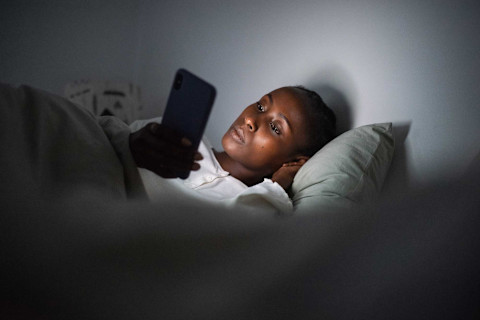Life is tough for night owls. For starters, being a late riser can feel like a personal failure in a society that equates early morning with productivity. Nine-to-five work and school schedules can also make night owls feel "behind" before they even get out of bed.
For the more nocturnal among us, the evening hours offer a much-needed breather. But they, too, can come with a dark side—and ironically, it results from too much light. Here's how light can mess with night owls' sleep schedule and how they can use it to their advantage.
Why light is harmful for night owls
First of all, let's set the record straight: There is no shame in going to bed late and waking up late if that's what your body prefers. Sleep (like many body processes) runs on a circadian clock, and there is a well-established genetic component1 to how this clock is set.
Some people really are born to relish in the nighttime hours, and there's nothing inherently wrong with that. It's only when night owls are forced to live by other people's schedules that problems can happen.
Later risers who have packed calendars from the moment they wake up might feel like the evening is their only time to catch up on chores, spend time with loved ones, and unwind. More often than not, they do so on phones, computers, and TVs, or in bright living rooms or bedrooms.
You might see what I'm getting at here: Night owls tend to be exposed to more light at night than early birds.
Light, be it from the luminescence of lamps2 or the glow of digital screens3, is a known suppressor of melatonin—a hormone that tells the body it's time for bed. If someone who is naturally inclined to stay up late has their melatonin suppressed, they will want to stay up even later. This can be a slippery slope toward delayed sleep phase4—a disorder in which sleep patterns are so delayed that they mess with sleep quality.
While there is no harm in being a night owl, having a delayed sleep phase does come with risks including insomnia, extreme drowsiness, and trouble staying alert during the day.
In an ideal, circadian-attuned world, we'd all live in sync with the light patterns outside our windows, spending the daytime in bright light and nighttime in pure darkness. Of course, that's just not realistic for most night owls—but these tips can be the next best thing.

Easy ways to reduce light exposure at night
1. Dim things down
Investing in dimmable lamps or attaching dimmers to existing bulbs is a quick way to limit unnecessary light. Place them in the rooms where you spend the most time at night and start to dim them two to three hours before you want to fall asleep.
2. Have two light sources
Another option that has the stamp of approval from a leading circadian health researcher is to keep two light sources in every room: one bright and bluer-toned (for daytime), one dimer and warmer (for nighttime). Once the sun sets, switch on the night light to better mimic what's going on outside.
3. Resist the urge to scroll
Spending the night on screens—particularly ones you hold close to your face—will flood your eyes with light (and potentially cortisol-raising content). Do your best to limit your screen time in the hours before bed and get into the habit of reading, journaling, etc., instead. Designating a small section of your living space for these activities using plush cushions, inviting fabrics, and—of course—dim lighting can make them all the more pleasurable. Remember: The best things in life are analog!
4. At the very least, limit blue light
For those nights when turning off your screens is impossible, there is some research to show that wearing blue-light-blocking glasses can make them less stimulating. One review of 24 sleep studies5 found that these glasses successfully reduced sleep onset latency (aka the time it takes to fall asleep) in those with sleep disorders, jet lag, and variable shift work schedules. Another study found that they successfully reduced melatonin suppression in teenage boys.
If you don't feel like shelling out for new frames, toggling on your phone or computer's "night mode" may also reduce their negative effects on melatonin production6 a bit.
The takeaway
By nature, some people tend to spend more of their nighttime hours immersed in artificial light, which can go on to derail their sleep. Thankfully, making a few simple tweaks around the house like investing in dimmable or night-specific lighting, limiting blue light exposure from devices, and designing space for screen-free activities can help keep night owls from perching past their bedtime.
6 Sources
- https://www.ncbi.nlm.nih.gov/pmc/articles/PMC6084759/
- https://academic.oup.com/jcem/article/96/3/E463/2597236?login=false
- https://pubmed.ncbi.nlm.nih.gov/21552190/
- https://journals.sagepub.com/doi/10.1177/0748730418757007
- https://www.tandfonline.com/doi/full/10.1080/07420528.2021.1930029
- https://www.sciencedirect.com/science/article/abs/pii/S0022395616307786?via%3Dihub
